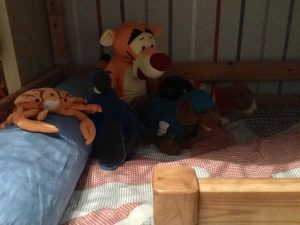
Nasal Allergies In Children
My child sneezes frequently in the morning, and often has itchy eyes. He snores at night, and seems exhausted by mid-afternoon. I suspect he may have nasal allergies. What can I do?
One of the most common environmental allergens causing nasal allergies is the house dust mite. It can lead to persistent nasal congestion, sinus irritation, nocturnal cough and poor sleep quality secondary to snoring and difficulty breathing. This poor sleep quality can then lead to a condition called daytime somnolence- excessive sleepiness and tiredness in the afternoon despite apparently having had enough hours of sleep.
Although many people turn immediately to medications such as nasal steroid sprays and antihistamines, or even surgical options, there are plenty of “non-medical” environmental modifications you can adopt which are often very effective.
1. Remove any soft toys from the bed
If your child has to have one soft toy (my middle child still can’t let go of his…), then Mr Smiggles will have to be washed in the washing machine on a high temperature cycle (60C) once a week, or be placed in a Ziplock bag in the deep freezer for 24 hours if he can’t go in the washing machine.
2. Try not to have rugs or carpets in the room
Try to remove any rugs or carpets from the bedroom. Thin rugs that can go in the washing machine should be washed weekly; big carpets that have to stay in the room should be regularly steam cleaned or shampooed.
3. Avoid feather pillows and duvets
Feathers are much more likely to harbour house dust mites than synthetic materials. Try to avoid using them if your child has nasal allergies.
4. Use anti-allergy mattress and pillow protectors.
These are readily available at any major department store, and act as a physical barrier to the house dust mite.
5. Wash all bedding in a hot (60 degrees) cycle at least weekly
The heat of the washing machine helps to kill the house dust mite. Similarly, drying the bedding in direct sunlight or in a hot tumble dryer will help to kill the house dust mite.
6. Remove as much dust as possible from the room
Dusting with a damp cloth is superior to using a dry one in that you scoop up the dust rather than moving it from one surface to another. Also, remember to vacuum behind and underneath the bed regularly to remove excess dust.
8. Avoid exposure to other potential allergens
Cigarette smoke can induce allergic reactions in sensitive children. Obviously, the most ideal solution is for the parent or caregiver to stop smoking. If, however, you are unable to stop smoking, try to smoke outside the home, and change your clothes before spending time with your children.
For some children with nasal allergies, fur and feathers can exacerbate symptoms of nasal allergies. If removing the pet is not an option (and it rarely is!), then brush your dog or cat regularly to remove excess hair and dander, and try to avoid allowing the cat or dog access to the bedroom, especially the child’s bed.
9. Medical options
If, after trying all the above interventions, you find that your child still has significant symptoms, then it is time to book an appointment to see your doctor. Nasal steroids are very effective at controlling symptoms; although many children find them uncomfortable to use initially, this usually improves within a few weeks, especially once the inflammation in the nose settles down. Antihistamines are sometimes used to control the symptoms of nasal allergies, although they are often less effective than nasal steroid sprays, and are best used as add on treatments rather than on their own.
If you enjoyed reading this article, do subscribe so you won’t miss any of the upcoming ones. Enter your email address in the top right-hand corner and hit the Subscribe button.

Leave A Reply